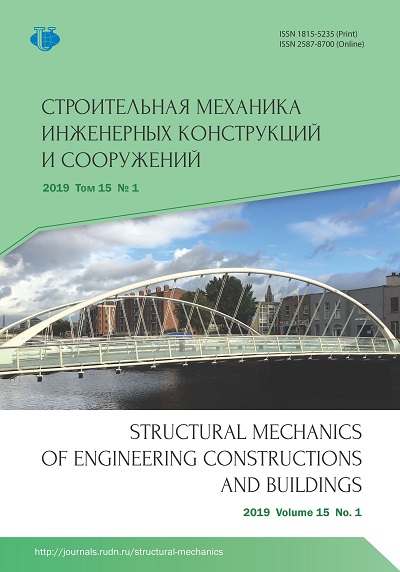Fire danger analysis of seismic expansion joints
- Authors: Madzhidov I.U1, Ibragimov B.T2, Suleymanov A.A3
-
Affiliations:
- Ministry of Higher and Secondary Special Education of Uzbekistan
- Institute of Fire Safety of MIA of the Republic of Uzbekistan
- Tashkent State Technical University named after Islam Karimov
- Issue: Vol 15, No 1 (2019)
- Pages: 75-80
- Section: Dynamics of structures and buildings
- URL: https://journals.rudn.ru/structural-mechanics/article/view/20721
- DOI: https://doi.org/10.22363/1815-5235-2019-15-1-75-80
Cite item
Full Text
Abstract
Aim of the research. Investigation of fire danger of seismic expansion joints, which have recently become almost the main component of seismic protection of buildings and structures. Identify the degree of fire danger of the building structure. Develop preventive measures to ensure fire safety of buildings and structures where seismic expansion joints are used. The relevance of this problem lies in the fact that the destruction of deformation seismic joints in seismic conditions for the spread of combustion (usually secondary occur in earthquakes) from one compartment of the building to another (protected by partitions, fire compartments, locks). That is, combustion opens the possibility to bypass special protections put in its way, in order to avoid its spread. Methods. Antiseismic deformation joints have been studied from the point of view of fire safety. The work mainly deals with the expansion joints used in the installation of aluminum panels for the design of buildings and structures. The connection of fire danger of antiseismic joints combined with technological and operational errors of performers is shown. Tests of various seismic protection joints for fire danger have been carried out. Results. It is concluded that it is necessary to develop a special regulatory documentation that introduces specific rules for the execution of expansion joints, especially designed to improve the seismic safety of buildings and structures.
About the authors
Inomzhon U Madzhidov
Ministry of Higher and Secondary Special Education of Uzbekistan
Author for correspondence.
Email: vazir@edu.uz
DSc in Technical Sciences, Professor
96 2-ya Chimbay St., Tashkent, 100100, Republic of UzbekistanBahrom T Ibragimov
Institute of Fire Safety of MIA of the Republic of Uzbekistan
Email: ibragimov-dem@yandex.com
PhD in Technical Sciences, Doctoral Candidate
4 Sergeli St., bldg. 1A, Tashkent, 100123, Republic of UzbekistanAdiljan A Suleymanov
Tashkent State Technical University named after Islam Karimov
Email: baxa332@gmail.com
DSc in Technical Sciences, Professor of the Life Safety Department
1-3 University St., Tashkent, 100100, Republic of UzbekistanReferences
- Akhmedov M.A. (2004). Assessment of damage to the most common types of construction of residential buildings in case of strong earthquakes in the Republic // Assessment of seismic hazard and seismic risk: Proceedings of the International conference, Tashkent, 20–33. (In Russ.)
- Balasanyan S.Yu., Nazaretyan S.N., Amirbekyan V.S. (2004). Seismic protection and its organization. Gyumri: Eldorado Publ., 436. (In Russ.)
- Suleymanov A., Kurbanbaev Sh.E., Ibragimov B.T. et al. (2017). The energy price of the probability of security from the spontaneous evolution of the system. Architecture and design: Scientific and Technical Journal of the Tashkent Institute of Architecture, (3–4), 108–111. (In Russ.)
- Kurbanbayev W.E., Suleimanov A.A., Magrupov A.M. (2018). The risk of energy dependence of security threat factor. Tashkent: IPB, Ministry of Internal Affairs of the Republic of Uzbekistan, 76–79. (In Russ.)
- Jaskiewicz M.V., Suleymanov A.A., Timanova V.V. (2018). Universal time vector in rescuing victims from the directional effects of the seismic fire factor. The Development of modern science: theoretical and applied aspects: collection of students' articles, graduate students, young scientists and teachers, 26, 58–59. Perm. (In Russ.)
- The order of the Ministry of the Russian Federation for civil defense, emergencies and elimination of consequences of natural disasters of 16.10.2017 No. 444 “On approval of the combat charter of fire protection units, which determines the order of fire extinguishing and rescue operations.” (In Russ.)
- Rasul-Zadeh D.A., Suleymanov A.A., Pudovkin A.A. (2018). The effectiveness of the advisory committees to mitigate the likelihood of risk units of action in emergency situations in the oil and gas industry. New information technologies in science: articles collection of the International scientific-practical conference. Chelyabinsk, 17–19. (In Russ.)
- Suleymanov А.А., Ibragimov B.T. (2017). Model test of a building design for destruction at influence of the compelled fluactuations. European science review, (9–10), 11–13.
- Ibragimov B.T., Suleymanov А.А. (2017). Research of Thermal and Mechanical Influence on Ferro-Concrete Designs with Damping Inserts. International Journal of Advanced Research in Science, Engineering and Technology, 4(9), 4595–4598.
- Kholmatov K., Musaev M.N., Khashimova D., Wei Wu. (2009). Geophysical site characterization of landfill in Usbekistan. Proceedings of the International Symposium on Geoenvironmental Engineering in Hangzhou, Hangzhou, September 8–10. Springer Verlag.
- Musaev M.N., Khashimova D., Kholmatov K. (2007). Management of environmental risks of landfill operation in seismically active regions of the CIS countries of Central Asia. In P. Fecko, V. Cablik (Eds.). Proc. 11th Int. Conf. on Environment and Mineral Processing, Ostrava, Czech Republic, 1, 17–22.
















